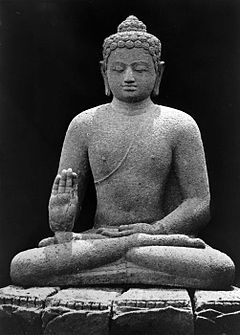

TYPE: The Fifth dhyanibuddha or meditation buddha
ORIGIN: Buddhist [India]
KNOWN PERIOD OF WORSHIP: circa 500 BCE to present.
SYNONYMS: Kharmaheruka
ART REFERENCES: metal and stone sculptures, paintings
LITERARY SOURCES: Sadhanamala and Tantric ritual texts.
INFORMATION: One of five mystic spiritual counterparts of a human buddha in Vajrayana Buddhism. A product of the Adibuddha who represents the branch of the cosmos concerned with consciousness. He originates from the green mantra HUM and lives in the northern paradise. His Sakti is Arya-Tara and he is normally accompanied by two Garudas or dwarfs.
CHARACTERISTICS:
Amoghasiddhi is associated with the conceptual skandha or the conceptual mind (as opposed to the non-conceptual or sensational mind). His action towards the promotion of Buddhist paths is the pacification of evils. This is symbolised by Amoghasiddhi's symbol, the moon. He gestures in the mudra of fearlessness, symbolising his and his devotees' fearlessness towards the poisons or delusions.
He is usually coloured green in artwork and is associated with the air or wind element. His season is autumn and his heavenly quarter is the northern buddha-ksetra called Prakuta.
In the Surangama mantra ( Chinese:Léngyán Zhòu ) taught in the Surangama sutra ( Chinese:Léngyán Jing ), an especially influential dharani in the Chinese Chan tradition , Amoghasiddhi is mentioned to be the host of the Karma Division in the North, one of the five major divisions which controls the vast demon armies of the five directions.
COLOR: Green
ATTRIBUTES: Staff and sometimes a seven-headed snake. Amoghasiddhi is also taken as a tutelary deity in Lamaism [Tibet] in which case his attributes include bell, three monkish robes, and prayer wheel.
EMANATIONS: include Visvapani and many other minor names.
See also Aksobhya, Amitabha, Ratnasambhava, and Vairocana